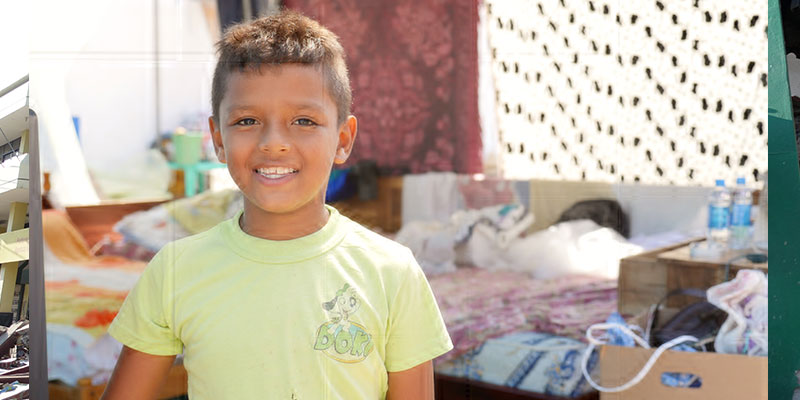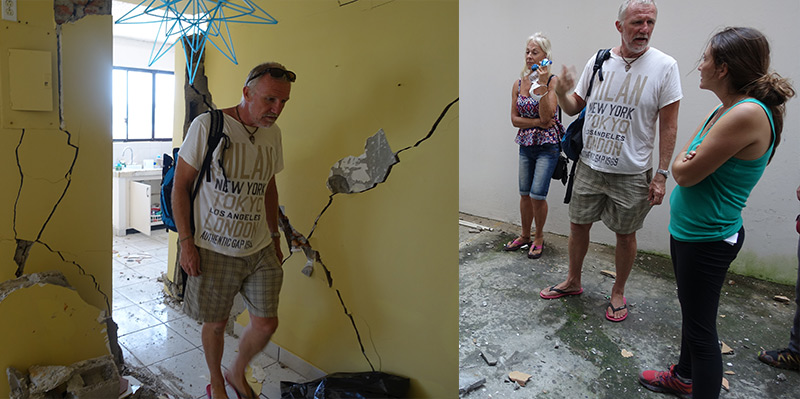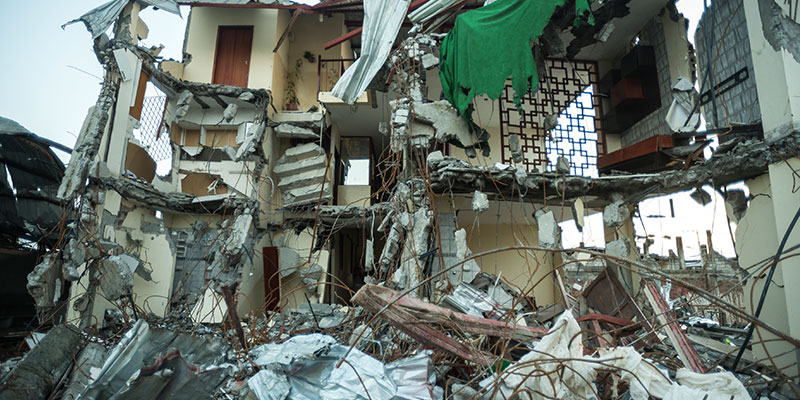7:15 am, April 25
As we pack the car to leave earthquake-ravaged Portoviejo in the cool morning air, the middle-aged owner of our rented jungle oasis in the disaster zone runs out to stop us. “I just want to say we really appreciate what you guys are doing here,” he says. “You are saving my town; you are saving my people. Can we take a picture with you?”
I encounter this often. We are treated as some sort of roving rock band with hard hats. The appreciation I have encountered everywhere humbles me. People are so generous to share water and shelter, even when they are very scarce.
Immediately outside of town, a panorama of vivid green fields and mountains under the pleasant morning sun unfolds. I have never seen some of these plants before. It’s a beautiful morning with high patchy clouds and not too hot yet.
Out here in the middle of this coastal paradise, it’s kind of hard to believe that people have endured a giant 7.8-magnitude earthquake, but plenty of signs along the road mark its legacy: A white-walled vacation home with Italian roof tiles tilted badly on slender columns; lines for water; a jagged crack in the road that our driver, Luis, swerves wildly to avoid, throwing the three of us in the backseat into each other like bowling pins. Too bad we cannot find workable seat belts. Let me tell you: flying at 70 mph over cracked, winding roads is much more risky than going to the half-collapsed buildings.

10:30 am
We are headed to Chamanga, an impoverished pueblo 157 kilometers (97 miles) north of Portoviejo, but we’ve promised a few stops along the way. In Bahía de Caráquez, we pull into a mall parking lot and see Steve and a blonde friend waiting for us in his open-air Jeep. We climb out of the car to greet him. The equatorial sun radiating off the blacktop parking lot and beating down on bare arms is intense. Steve, who makes me think he might have been a surfer back in the 1960s with his board shorts, t-shirt, sandals and cheerful, laid-back attitude, shakes my hand with a “Hey, Kit, thanks for coming.”
Diana, our communication specialist, Juan, and I hop into his back of the Jeep and the others follow. We drive through Bahía, located on a sandy peninsula at the mouth of the Chone River, with Steve pointing out key buildings amid heavy earthquake destruction. A woman and her son find shade beneath a building with a large gash in it. A five-story building with a wall that looks like it would fall any minute. A row of tents housing people too frightened to return to homes, although they smile and greet you like nothing has happened. Diana snaps a photo of a handsome boy with a brilliant smile from the tent city.

On the next block, the owners of tiny establishments are setting up food carts to offer plates of cevichochos, parillada or various soups for lunch. People cheerfully greet Steve. He is an American retiree living in this kick-back coastal, colonial town, which has been turned into heaps of concrete debris.

Heavy machinery carts away tons upon tons of debris, a challenge in itself in every one of these damaged cities. In this downtown area, it appears that about one-third of the buildings are a complete loss. Steve drives us by the site of brand new, yellow and white, eight-story twin towers. One looks perfectly fine; the other was reduced to total rubble. “They were built the same way, at the same time, by the same people,” he says, puzzled. “One collapsed and killed 12 people, included the developer, but the second has no cracks.”
I see this quite often, I say. In the 2008 Sichuan Earthquake, I walked through a complex of high-rise apartments. Same thing. Some were gone. Some had some damage and others had no damage. Almost like someone from above just picked buildings to live or die. Earthquake response is random. It’s possible that it was faulty construction or something different in the concrete. Or the soil was different. Maybe there are slight architectural differences. Little things make a big difference in earthquake response. Quality is a very important thing. That’s why engineers and contractors working together is important – to make sure they understand this.

We drive to Steve’s building in a neighborhood of many oceanfront high-rise condos, nearly all of them with exterior cracks exactly like what I’ve seen in Kathmandu, Nepal. Different continent, same tragedy. All of them new or nearly new high-rise apartments. No one died, but the damage was so severe, recovery was difficult if at all. Everyone knows an earthquake is possible, but they never expect this.
We’ve climbed maybe 200 levels in the past four days, so we climb five more. Obviously, the elevators are not operational. Steve unlocks the door to one of three places he owns in this building, a retirement investment in paradise. Inside, is a beautiful corner oceanview room; the blue Pacific Ocean opens up in all angles with large chunks of concrete on the floor and heavily cracked walls. We rapidly check columns and structural walls. I say to Steve, “It seems that structural damages may be very limited, but a detailed investigation should be conducted. The good news is, it is repairable. It would also be very helpful to not only put back same old brick, but to add some reinforcement. It will reduce the damages next time.”
Other retirees show up from nowhere asking us to check their condo-apartments. We planned to spend two hours, but spend half a day. A nice, young couple with pleasant smiles shows up from across the river in San Vicente. The woman speaks English very well. She wears a green workout top, black yoga tights and bright pink shoes. Her face is tanned, and although she is young, she’s also exhausted. “People in our village are sleeping outside, fearful,” she says. “They’ve been told their houses are falling down and don’t know what to do and no one has come to help them. Can you come with us to see?”
1:38 pm
“The damage is essentially minor plaster cracks and they can be repaired,” I tell the owner…
I have trouble saying no to people who don’t have the technical knowledge we do and need answers. Everyone deserves to know whether their house is safe or not. Helping people move on with life after a disastrous earthquake it is very important. As it turns out, she was raised in the states, but came to her parents’ village in Ecuador every summer as a child. “It was cheaper than summer camp,” she jokes. Now she lives here.
We drive to her village and walk through a typical house with typical damage. I have seen thousands of these houses in dozens of countries. This one is a two-story concrete house with a porch under columns. Tin roof. The house has slight cracks here and there and some ground settling, but nothing structurally major. “The damage is essentially minor plaster cracks and they can be repaired,” I tell the owner, a small woman in a brown dress. A smile lights up her face. I say to a young couple, “I think this city needs proper damage assessment. Ecuador has this tool, which I have seen them using in Portoviejo. We will get the information and send to your city engineer.”
She visibly relaxes. “Good, that’s just what I need,” she says. I feel good seeing this young woman and her husband taking a leadership role in the village of her parents. No one asked them to do. But they just stand up.
2:18 pm
We leave the village and drive up the coastline with the sun shimmering off the Pacific Ocean to our left, zig-zagging around cracks in the road left by the earthquakes. A large landslide has wiped out part of the road, so we continue over dirt under the road picks up again. We pass a sign marking the equator and flip the car around to backtrack for a photo. Then on to Chamanga!

We detour in the coastal resort town of Pedernales, perhaps the worse hit by the earthquake, with 172 dead and 53 still missing. I feel like we are a boat crew from a 1980s movie Apocalypse Now, who rode through war-torn towns in Vietnam as we are doing now. Many NGOs and resources are here to help, perhaps the most we’ve seen. Strangely, we’ve not seen international media anywhere. They came for the story in the beginning and left.
But this story is not over. The country faces a long recovery. Everywhere in Pedernales, large earthmovers scoop up people’s former lives and livelihoods. I have never seen a country dive into the removal of collapsed buildings so quickly. It’s just over one week after the earthquake and my guess is that half of the collapsed buildings have been removed. Many buildings here were flattened like pancakes. Building after building of destroyed walls and twisted rebar. With concrete structures, anything built prior to the 1990s is fairly dangerous. They simply don’t have adequate rebar to hold the concrete together during a big shake. I also suspect they used sea sand for the concrete. Salt erodes the rebar. Both are huge problems throughout the world.

We walk through the worst part – a ghost town – to better understand the damage. As we walk the empty streets, we come across an older man on a motorcycle with a huge dent in the gas tank. “My house fell down and my car was destroyed, but I got up the next day with only these clothes and went to work,” he said. “What else can I do?” People are resilient in disasters. We often saw small shops open in less damaged buildings among the destruction. People need to make living. They are resourceful and creative. Governments just need to facilitate the process. But I often encounter governments that unknowingly work against what people try to do. In panic, many governments react very conservatively and ignore the tenacity that people and small business have to move forward and rebuild.
Down on the beach, we happen to find an operating restaurant in a small shack. It doesn’t even qualify as a “hole in the wall.” The adjacent building is totally collapsed. Eating here – or anywhere, really — is the idea of our fellow engineer, Arcesio, who is perpetually hungry. Our schedule usually prevents us from eating until about 4 pm each day. The place is packed with relief workers. I am sure this place was busy with tourists before the disaster, but now they are replaced with Red Cross workers and us. Diana orders an arroz marinero teaming with fresh morsels from the sea and Juan and I share some kind of whole fish in a creamy, yellow sauce. Delicious. It is unreal to eat such a meal here. It is probably the best meal we ever eaten for a whole week. Here in a shack with a huge wreck of a building leaning against it.

6:48 pm
At dusk, we finally reach our destination, Chamanga, a poor fishing village tucked into a bay that Arcesio and his colleagues building the university town of Yachay more than 250 miles away want to help. The relationship is a study of contrasts. Yachay, near Quito, is a government project: a $1.04 billion research university and “City of Knowledge” under construction that’s been called the Silicon Valley of the Tropics and the Singapore of the Andes. Chamanga is a struggling pueblo of rotted wood and concrete houses that regularly floods and sits in a tsunami zone without any warning system. More than half of structures are either collapsed or about to. The villagers want to move the entire city to higher ground and Arcesio, the civil engineer traveling with us, wants to help them.

Most of the people here in Chamanga are of African descent. A 40-something man with stunning green eyes tells us, “We lost more than half of our homes and 6,000 people are sleeping in tents set up by relief organizations.” They take us to one of four schools in the village. I see collapsed walls with a tin roof that is somehow, magically, still standing. There is no way that this can be repaired. Around us, happy children in brightly colored pants and pastel shirts make up games using sticks. Fishermen return to a little wharf badly destroyed in the earthquake. The sun sets as mosquitoes buzz to life around us. We’ve been warned that malaria is on the rise. I feel pricks through my t-shirt.

12:30 pm April 26, Ecuador Day 5

After a humble celebration of the birthday of our driver, Luis, the night before, we head out to Quito where the mayor has asked to meet us. It is at least six hours away on twisting, winding roads through the Andes. Arcesio takes the wheel and drives like a scene from Madmax. It is an all-day, hellish, endless Indiana Jones ride at Disneyland without a seat belt, only the perils of oncoming boulders, trucks and earthquake debris in the road are real.
We stop to put air in the tires. Twice. Not the best feeling. As we drive, the messages on my phone keep arriving: Steve in Bahía. The colonel we met with in Quito. Patricio, the recovery planner in Portoviejo. The mayor in Quito is passing on soccer tickets to meet with us.
Our beat-up SUV rambles up the Andes road, tires screeching. I tell the team, “Many engineers show up, collect the data, and go home. That’s not what we do. Once you’ve met the people and engaged in a situation, you have to do more. We’ve been to so many disasters. We know what should be happening and what will happen. Our experience is a precious commodity and we need to share it. We need to come back here.”
As dusk closes in around us, heavy tropical rains start pounding on the windshield. Quito is still a long way.

